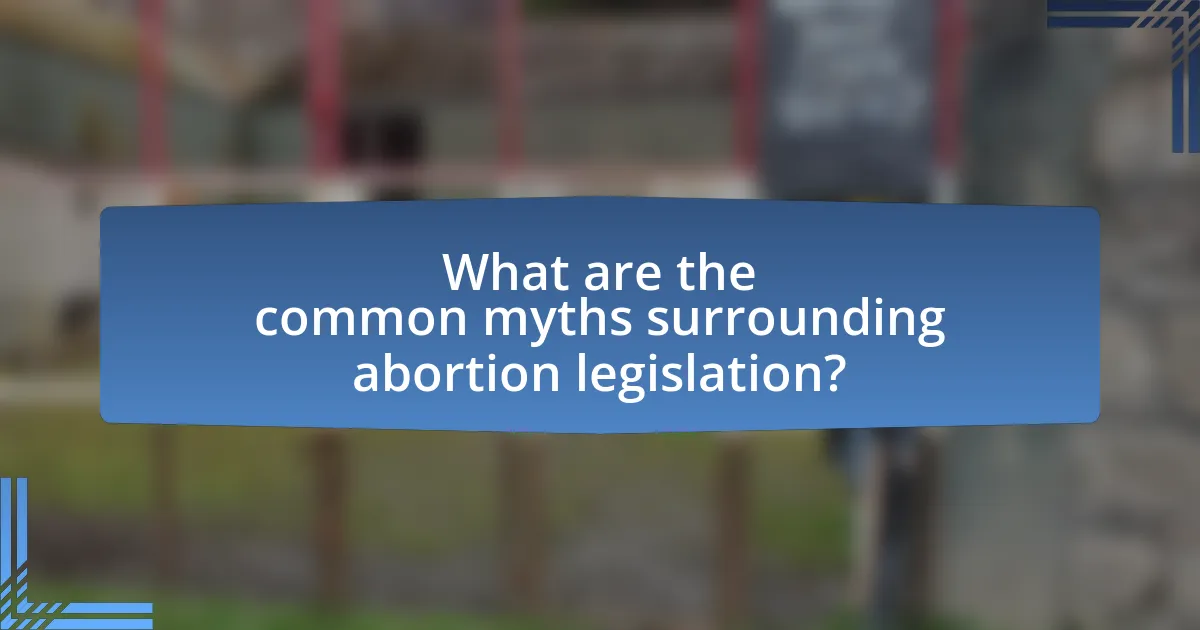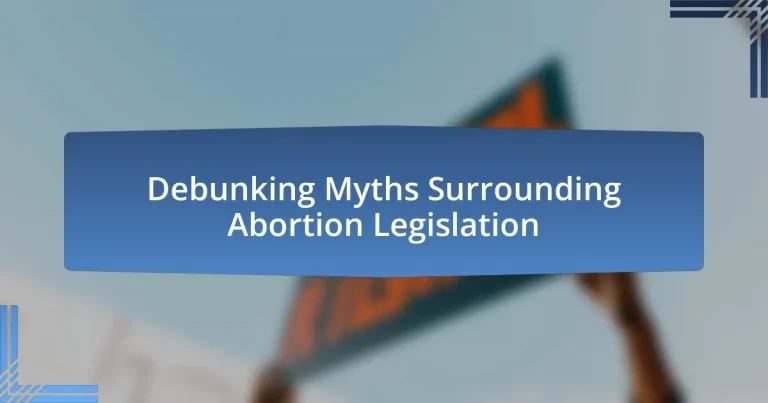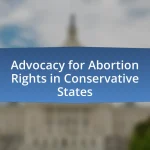The article focuses on debunking common myths surrounding abortion legislation, addressing misconceptions such as the belief that abortion leads to significant mental health issues, is primarily used as contraception, and is a dangerous procedure. It highlights research indicating that most women do not experience long-term psychological harm after an abortion, and that legal abortions, when performed by qualified professionals, are generally safe. The article also explores how these myths distort public perception, influence legislative decisions, and perpetuate stigma, while emphasizing the importance of accurate information in shaping informed public discourse and policy. Additionally, it examines the variations in abortion laws across different jurisdictions and the broader implications of these laws on women’s health, rights, and economic stability.

What are the common myths surrounding abortion legislation?
Common myths surrounding abortion legislation include the belief that abortion leads to significant mental health issues, that it is primarily used as a form of contraception, and that it is a dangerous procedure. Research from the American Psychological Association indicates that most women do not experience long-term psychological harm after an abortion. Additionally, data from the Guttmacher Institute shows that the majority of women seeking abortions do so for reasons related to personal circumstances rather than as a primary method of birth control. Furthermore, medical studies confirm that legal abortions, when performed by qualified professionals, are generally safe, with a low complication rate.
How do these myths impact public perception of abortion laws?
Myths surrounding abortion significantly distort public perception of abortion laws by perpetuating misinformation and fear. For instance, the myth that abortion leads to severe mental health issues has been debunked by studies, such as those published in the American Journal of Psychiatry, which found that the majority of women do not experience long-term psychological harm after an abortion. This misinformation can lead to increased stigma and pressure on lawmakers to impose restrictive laws, as public opinion sways towards the belief that abortion is inherently harmful. Additionally, myths suggesting that abortion is a common method of birth control can create a perception that women are irresponsible, further influencing legislative decisions that restrict access to abortion services. Thus, these myths not only shape individual attitudes but also contribute to a legislative environment that may not reflect the actual needs and experiences of women.
What are the origins of these myths in society?
The origins of myths surrounding abortion legislation in society stem from historical, cultural, and political contexts. These myths often arise from misinformation, religious beliefs, and societal norms that shape public perception. For instance, the association of abortion with moral decay has roots in various religious doctrines that view it as a sin, influencing legislation and public opinion. Additionally, political agendas have exploited these myths to mobilize support or opposition, as seen in the debates surrounding Roe v. Wade in the United States, where misconceptions about the implications of abortion laws were prevalent. Research indicates that these myths can perpetuate stigma and misinformation, impacting women’s health and rights.
How do media portrayals contribute to these misconceptions?
Media portrayals contribute to misconceptions about abortion legislation by often emphasizing sensationalized narratives over factual accuracy. For instance, news outlets frequently highlight extreme cases or personal stories that evoke strong emotional responses, which can skew public perception and create a belief that such instances are representative of the broader reality. Research from the Guttmacher Institute indicates that media coverage often lacks context regarding the legal and medical complexities of abortion, leading to misunderstandings about the actual implications of legislation. Furthermore, studies show that repetitive exposure to misleading information in media can reinforce false beliefs, making it difficult for audiences to discern factual information from sensationalized portrayals.
Why is it important to debunk these myths?
Debunking myths surrounding abortion legislation is crucial to ensure informed decision-making and public discourse. Misinformation can lead to misguided policies and societal stigma, which negatively impact women’s health and rights. For instance, studies show that misconceptions about abortion safety can deter individuals from seeking necessary medical care, resulting in adverse health outcomes. By clarifying these myths, stakeholders can promote evidence-based policies that protect reproductive rights and improve health outcomes for women.
What are the consequences of misinformation on abortion legislation?
Misinformation on abortion legislation leads to significant consequences, including the enactment of restrictive laws and public confusion. When false information circulates, it can sway public opinion and influence lawmakers to adopt policies that may not reflect the actual needs or views of the population. For instance, studies have shown that misinformation can result in increased stigma surrounding abortion, which may deter individuals from seeking necessary healthcare services. Additionally, a report by the Guttmacher Institute indicates that states with higher levels of misinformation often implement more stringent abortion regulations, impacting access to safe and legal procedures.
How can debunking myths lead to informed decision-making?
Debunking myths leads to informed decision-making by providing accurate information that challenges misconceptions. When individuals are exposed to factual data about abortion legislation, such as the actual statistics on safety and outcomes, they can make choices based on reality rather than fear or misinformation. For instance, research from the Guttmacher Institute indicates that legal abortions are safe, with a complication rate of less than 1%. This evidence allows people to understand the implications of legislation more clearly, fostering decisions that are grounded in truth rather than myths.

What are the key facts about abortion legislation?
Abortion legislation varies significantly across different jurisdictions, with key facts including the legal status, gestational limits, and requirements for obtaining an abortion. In the United States, for example, the Supreme Court’s decision in Roe v. Wade (1973) established a woman’s legal right to choose an abortion, but this was overturned by Dobbs v. Jackson Women’s Health Organization in 2022, allowing states to regulate or ban abortions. Many states impose gestational limits, often ranging from six to twenty-four weeks, and may require waiting periods, parental consent for minors, or mandatory counseling. Globally, countries like Canada and the Netherlands have more liberal laws, allowing abortions on request, while others, such as Poland and El Salvador, have highly restrictive laws or total bans. These variations reflect differing cultural, religious, and political contexts surrounding the issue of abortion.
How do different countries approach abortion laws?
Different countries approach abortion laws with varying degrees of restriction and accessibility. For instance, in the United States, abortion laws differ by state, with some states imposing strict regulations while others allow for broader access. In contrast, countries like Canada and the Netherlands have more liberal laws, permitting abortion on request during the first trimester and beyond under certain conditions. In contrast, nations such as Poland have highly restrictive laws, allowing abortion only in cases of severe fetal abnormalities or when the mother’s life is at risk. These differences reflect cultural, religious, and political influences on reproductive rights, demonstrating a spectrum from highly permissive to severely limited access to abortion services.
What are the variations in abortion legislation across states?
Abortion legislation varies significantly across states in the United States, with some states imposing strict regulations and others maintaining more liberal access. For instance, states like Texas and Alabama have enacted laws that severely restrict abortion access, including mandatory waiting periods, parental consent requirements, and gestational limits, while states such as California and New York have laws that protect the right to choose and ensure access to abortion services without excessive restrictions. According to the Guttmacher Institute, as of 2023, 13 states have enacted total bans on abortion, while 16 states have laws that protect access to abortion throughout pregnancy, illustrating the stark contrast in legislative approaches.
How do cultural factors influence abortion laws globally?
Cultural factors significantly influence abortion laws globally by shaping societal attitudes, religious beliefs, and gender roles. For instance, in predominantly Catholic countries like Poland and Malta, strong religious beliefs lead to restrictive abortion laws, reflecting the cultural emphasis on the sanctity of life. Conversely, in more secular societies such as Canada and the Netherlands, cultural acceptance of reproductive rights results in more liberal abortion legislation. Research indicates that countries with higher gender equality, such as Sweden, tend to have more progressive abortion laws, as cultural norms support women’s autonomy and reproductive choices. Thus, cultural contexts directly impact the legal frameworks surrounding abortion, demonstrating the interplay between societal values and legislation.
What legal frameworks govern abortion rights?
Abortion rights are governed by a combination of constitutional law, statutory law, and international human rights frameworks. In the United States, the landmark Supreme Court case Roe v. Wade (1973) established a woman’s legal right to choose an abortion under the constitutional right to privacy, which has been a foundational legal framework for abortion rights. Additionally, various state laws regulate the conditions under which abortions can be performed, leading to a patchwork of regulations across the country. Internationally, treaties such as the Convention on the Elimination of All Forms of Discrimination Against Women (CEDAW) influence abortion rights by promoting women’s health and reproductive rights. These legal frameworks collectively shape the accessibility and regulation of abortion services.
What role do Supreme Court decisions play in shaping abortion legislation?
Supreme Court decisions play a critical role in shaping abortion legislation by establishing legal precedents that influence state and federal laws. For instance, the landmark case Roe v. Wade in 1973 recognized a woman’s constitutional right to choose an abortion, which led to widespread changes in state laws across the United States. Subsequent rulings, such as Planned Parenthood v. Casey in 1992, upheld the core principles of Roe while allowing states to impose certain regulations, further impacting how abortion laws are crafted and enforced. These decisions create a legal framework that guides lawmakers, often resulting in significant shifts in public policy and access to abortion services.
How do state laws differ from federal laws regarding abortion?
State laws regarding abortion can differ significantly from federal laws, primarily in terms of restrictions and regulations. While federal law, established by the Supreme Court’s 1973 decision in Roe v. Wade, guarantees a woman’s right to choose an abortion before fetal viability, many states have enacted laws that impose additional restrictions, such as waiting periods, mandatory counseling, and limitations on when and how abortions can be performed. For example, some states have passed laws banning abortions after a certain number of weeks, which can conflict with the federal standard. Additionally, states have the authority to regulate abortion clinics, leading to variations in access and availability across the country. These differences illustrate the ongoing tension between state and federal authority in the realm of reproductive rights.

What are the implications of current abortion legislation?
Current abortion legislation significantly impacts women’s reproductive rights and healthcare access. For instance, restrictive laws can lead to increased maternal mortality rates, as evidenced by a study published in the American Journal of Public Health, which found that states with more abortion restrictions have higher rates of maternal deaths. Additionally, such legislation often disproportionately affects marginalized communities, limiting their access to safe and legal abortion services. This can result in a rise in unsafe abortion practices, as reported by the World Health Organization, which states that unsafe abortions contribute to approximately 47,000 deaths annually worldwide. Thus, the implications of current abortion legislation are profound, affecting health outcomes, equity in healthcare access, and overall societal well-being.
How does abortion legislation affect women’s health and rights?
Abortion legislation significantly impacts women’s health and rights by determining access to safe and legal abortion services. Restrictive laws often lead to increased health risks for women, as they may resort to unsafe procedures when legal options are limited. For instance, a study published in the American Journal of Public Health found that states with more restrictive abortion laws have higher rates of maternal morbidity and mortality. Furthermore, such legislation can infringe on women’s rights by limiting their autonomy over reproductive choices, which is recognized as a fundamental human right by organizations like the World Health Organization. Thus, the interplay between abortion legislation and women’s health and rights is critical, as it directly influences both their physical well-being and their ability to make personal health decisions.
What are the potential health risks associated with restrictive abortion laws?
Restrictive abortion laws can lead to significant health risks for individuals, including increased rates of unsafe abortions, complications from carrying unwanted pregnancies, and mental health issues. Research indicates that in regions with stringent abortion restrictions, individuals often resort to unsafe methods, resulting in higher morbidity and mortality rates. For instance, the World Health Organization reports that unsafe abortions contribute to approximately 47,000 deaths annually worldwide. Additionally, unwanted pregnancies can lead to adverse health outcomes, such as preterm birth and low birth weight, which are associated with long-term health complications for both the mother and child. Mental health risks, including anxiety and depression, are also heightened due to the stress of unwanted pregnancies and the stigma surrounding abortion.
How do abortion laws impact access to reproductive healthcare?
Abortion laws significantly impact access to reproductive healthcare by either restricting or facilitating services related to abortion and other reproductive health needs. For instance, stringent abortion laws often lead to fewer clinics and healthcare providers willing to offer reproductive services, which can result in increased travel distances for patients seeking care. According to a study published in the American Journal of Public Health, states with more restrictive abortion laws have been associated with higher rates of unintended pregnancies and maternal morbidity, indicating that such laws can create barriers to comprehensive reproductive healthcare.
What are the economic implications of abortion legislation?
Abortion legislation has significant economic implications, influencing healthcare costs, workforce participation, and overall economic productivity. For instance, studies indicate that access to abortion services can lead to increased labor force participation among women, contributing to economic growth; the Guttmacher Institute reported that women who can control their reproductive choices are more likely to pursue higher education and stable employment. Additionally, restricting access to abortion can result in higher healthcare costs due to increased rates of unintended pregnancies and associated complications, as highlighted by research from the National Bureau of Economic Research, which found that states with more restrictive abortion laws face higher public health expenditures. Thus, the economic implications of abortion legislation are profound, affecting both individual financial stability and broader economic outcomes.
How does access to abortion services affect economic stability for women?
Access to abortion services significantly enhances economic stability for women by allowing them to make informed decisions about their reproductive health and family planning. When women have the ability to choose whether to continue a pregnancy, they can better manage their educational and career aspirations, leading to increased workforce participation and earning potential. Research from the Turnaway Study indicates that women who are denied abortions are more likely to experience economic hardship, with 74% of those denied reporting that they were living below the federal poverty level within a year. This demonstrates that access to abortion services is crucial for women’s financial independence and overall economic well-being.
What are the broader economic impacts on society from restrictive abortion laws?
Restrictive abortion laws negatively impact society’s economy by limiting women’s workforce participation and increasing healthcare costs. When women are denied access to safe and legal abortion services, they may face unintended pregnancies that can hinder their ability to pursue education and employment opportunities. According to a study by the Institute for Women’s Policy Research, women who have access to abortion are more likely to complete their education and participate in the labor force, contributing to overall economic growth. Additionally, restrictive laws can lead to higher healthcare expenses due to complications from unsafe abortions and increased reliance on social services, further straining public resources. These economic consequences highlight the broader societal costs associated with limiting reproductive rights.
What can individuals do to support accurate information about abortion legislation?
Individuals can support accurate information about abortion legislation by actively sharing verified data from reputable sources. Engaging with organizations such as the Guttmacher Institute or the American Civil Liberties Union, which provide research and analysis on abortion laws, helps disseminate factual information. Additionally, individuals can participate in discussions on social media platforms, correcting misinformation by referencing credible studies and statistics, such as the fact that nearly 1 in 4 women in the U.S. will have an abortion by age 45, according to the Guttmacher Institute. By promoting evidence-based resources and fostering informed conversations, individuals contribute to a more accurate public understanding of abortion legislation.


